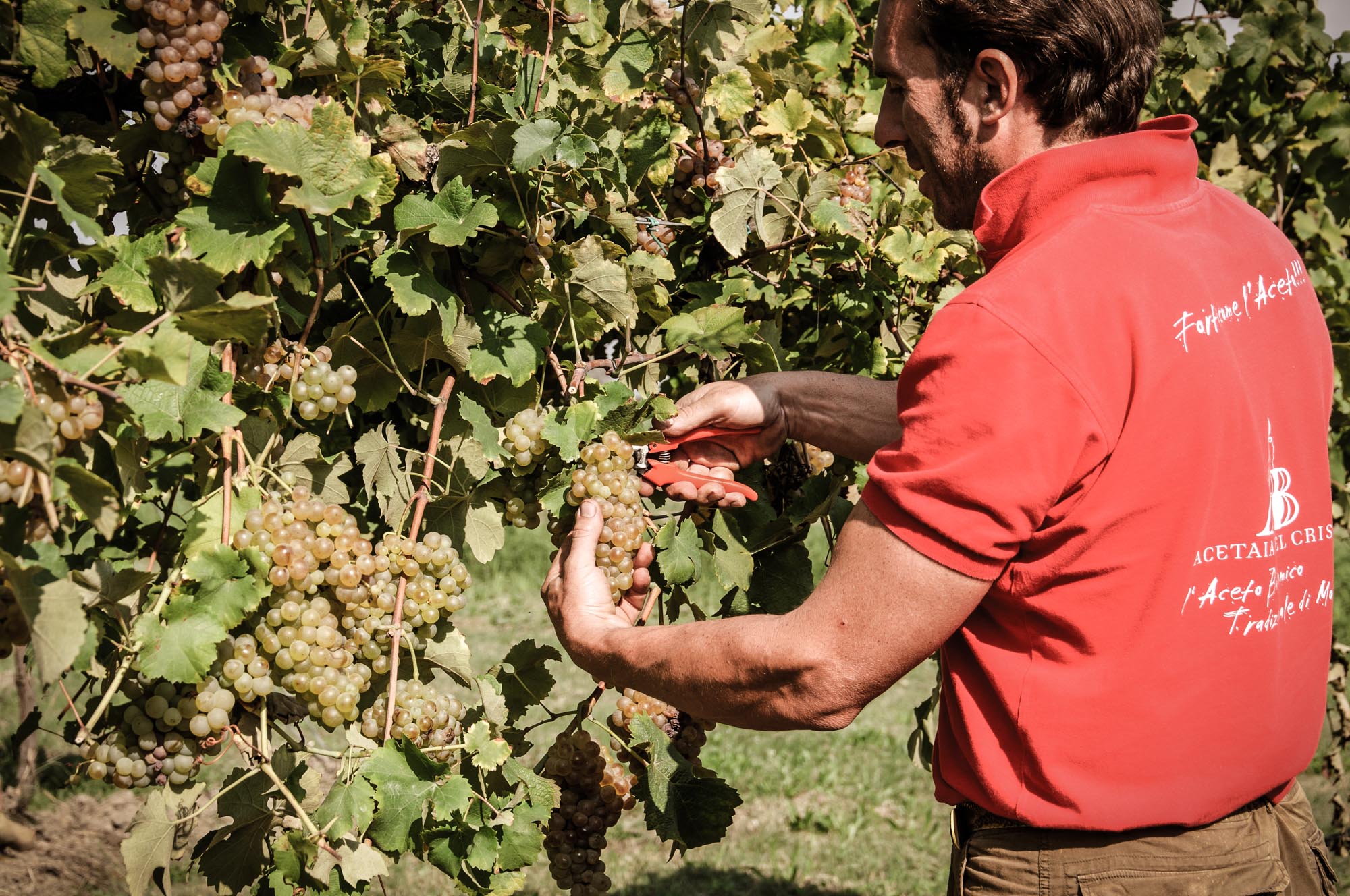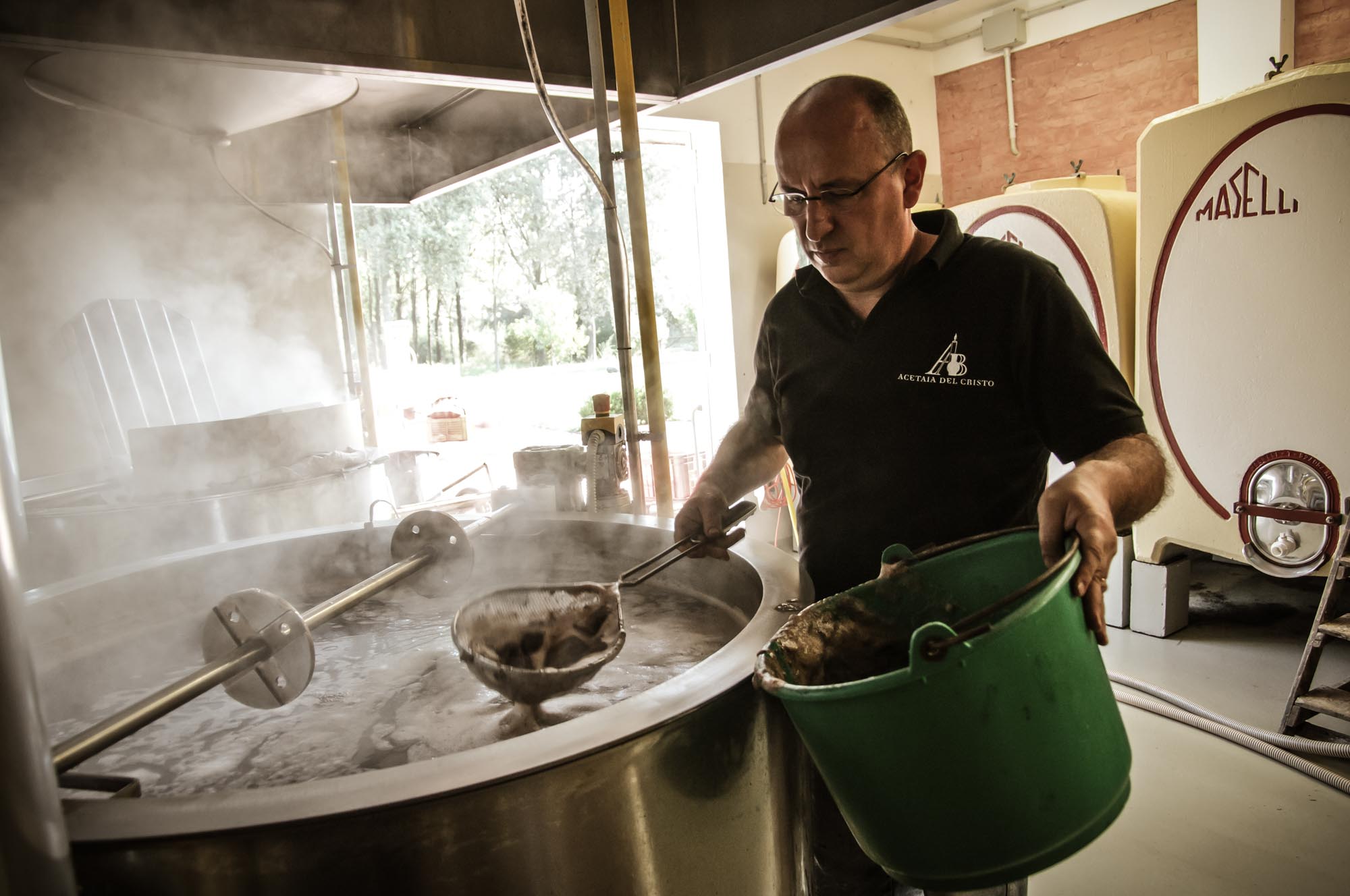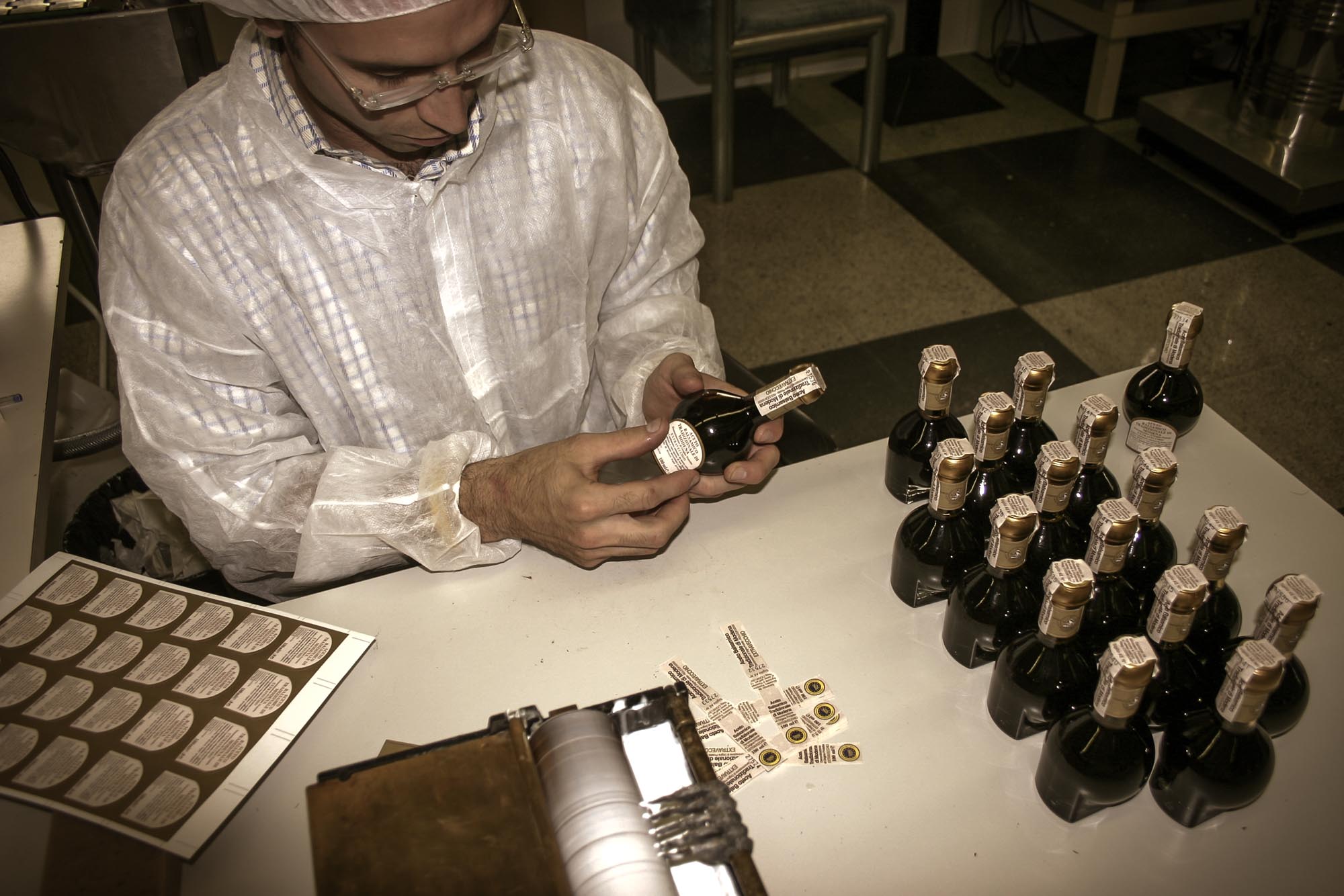
Production
Respect for the rhythms of nature
We believe that long and patient aging and the characteristics conveyed by the different barrel woods, as tradition dictates, are the basis of the true success of Traditional Balsamic Vinegar of Modena PDO: the perfect sublimation of inimitable scents, aromas and flavors.
Grapes
Obtained only from the Organic cultivation of its vineyards, we begin the production of that product, famous all over the world, named and acclaimed as Traditional Balsamic Vinegar of Modena PDO.
The hand-harvested grapes still used today are: Trebbiano di Spagna, Sauvignon Spergola and Lambrusco di Sorbara and Salamino. The use of a blend composed of various qualities of both white and black grapes gives the product a bouquet of special characteristics, aromas and flavors not otherwise obtainable.
The crushing
Immediately after the harvest, before alcoholic fermentation even begins, we turn our attention to crushing the grapes.
At one time it was the delicate feet of gentle maidens that caressed the bunches of grapes while today, with the same respect, a sophisticated pneumatic press allows the grapes to be softly crushed, obtaining only the noblest part of the must (by direct explosion of the berry), avoiding “squeezing” the tannins from the skins, seeds and stems as well.


The must
Cooking
The must, first cooled, is left to decant at low temperatures 2/3°C for several days before cooking.
Careful cleaning is followed by the delicate phase of cooking, which requires enormous care, experience and attention.
Modern steel boilers, with open vessel and direct fire, regulate the temperature so that the process is accomplished in a few hours and without suffering physical stress that might otherwise give rise to the strinato/bruciato flavors or otherwise other imperfections.
Alcoholic fermentation
The almost doubled sugar concentration and sterilization, the result of cooking, predispose the must to accommodate special yeasts, naturally selected from native strains over generations, directly from our families.
Today, in fact, through refrigerated containers, natural fermentation takes place moderately and linearly without thus burning any aroma.
Acetic bi-oxidation
With the first warmth of spring, the alcohol is then transformed into acetic acid by equally peculiar and characteristic microorganisms: acetobacteria.
Only after slowly developing a high degree of acidity, in large, old barrels (called mother barrels or abbesses), will the must go into the first barrels of the batteries in the following years.

The vinegar house
The historical and optimal location for “Traditional Balsamic” is in attics: places most exposed to large temperature ranges and where tranquility reigns supreme.
Harsh winters favor decanting, torrid summers facilitate fermentation and evaporation in the times.
The battery
It is easy to guess that the progressive and high concentration and the many delicate processes of evolution cannot take place simultaneously in the same container: for this reason, the production unit of Traditional Balsamic Vinegar does not consist of a single barrel but of a set of barrels with different woods and scalar dimensions, which is called BATTERY (from a minimum of 5 up to 10-12 barrels); we personally believe that 7 barrels constitute the right balance.
The differentiation of woods between one barrel and another gives a valuable bouquet of aromas and peculiar characteristics. The typical traditional woods are: oak, chestnut, mulberry and juniper to which cherry was later added, then acacia/robinia and finally ash.
Of paramount importance is the level of filling of the barrels, ¾ or slightly more of the total volume, thus exposing the maximum surface area to oxygenation and promoting the microbiological activities of yeasts, acetobacteria and enzymes.
Maturation
Time, evaporation and the undisputed industriousness of the microorganisms that populate Traditional Balsamic Vinegar of Modena lead to the creation of an environment that is hostile to their existence.
Particular enzymes thus favor a slow and natural process of lysis, generating additional aromas proper to “Balsamic”.
Aging
Only long, interminable, eternal, periods in barrels of ever-shrinking shapes will enhance finesse or any snubs of aroma and taste, singing or cursing the conduct of the “Master of VinegarWorks.”
Decanting and backfilling
There are two seasons of “Balsamic“:
“the hot” during which microbiological transformations and concentration by evaporation of water take place;
“the cold” favors rest and decantation elevating the clarity of the product.
The passage of small quantities (about 10%) from barrel to barrel, operating on the surface, is repeated every year at the end of winter, that is, when the Balsamic shines with maximum clarity.
Each barrel will receive from its predecessor only a small amount of Vinegar (about 15%), to bring it back to the right level.
The withdrawal
Only after at least 12 years for Traditional, 25 for Extra-Old (the two categories recognized by law), can a minimum quantity be taken.
Neither 10 percent of the contents of the smallest Vasello nor 3 percent of the total contained in the battery should be exceeded at all, so as not to compromise quality and performance in the years to come.
Obviously, it is not enough to certify aging; it is essential that it has fostered the full development of the necessary organoleptic qualities.

D.O.P. Certification.
The consortium
With the “Consortium for the Protection of Traditional Balsamic Vinegar of Modena – ABTM” the world of Traditional Balsamic Vinegar of Modena now enjoys renewed vitality: all the forces involved, institutions, producers and associations have rediscovered the natural identity of objectives such as defending the quality of the product, promoting it in the markets and safeguarding not only the product but also the entire cultural heritage and traditions of Modena.
Grapes, in fact, are the origin of balsamic vinegars, but it is the atavistic patient wisdom of the people of Modena that has created unparalleled products.
The ABTM Protection Consortium, by bringing together in its Board of Directors the forces of institutions, industry associations and producers, has improved its values and potential, with a strong commitment to improving services to members and promoting the product. The ABTM Protection Consortium is headquartered at the Chamber of Commerce CCIAA of Modena Via Ganaceto, 134 – and the operational headquarters also in Modena at Viale Virgilio, 55 – (www.balsamicotradizionale.it)
The conferment
Every stage of marketing must take place under the watchful supervision of the certifying body.
Three samples are taken during the phase of delivery of each batch from the Acetaia to the ABTM Protection Consortium:
– one remains in the archives of the ABTM Protection Consortium itself for possible future verification;
– a second is sent to a specialized analysis laboratory;
– a third is subjected to organoleptic examination by expert examiners appointed from time to time by the certifying body.
Pending the outcome of both analyses, the entire batch remains sealed in its container and stored in the ABTM Protection Consortium vault.
Only after a positive response certifying its excellent quality has been issued is the Consortium’s bottling center responsible for decanting, in the presence of the producer, into the appropriate ampoules (by law exclusively 100 ml, designed by Giugiaro Design).
The tasting
The Quality of musts, careful execution, technique and experience handed down and acquired from generation to generation, are officially certified by the Tasting Commission (composed of 5 “sommeliers” licensed with the Chamber of Commerce of Modena).
These professionals, filling out a ‘special tasting form, give each Vinegar for its visual, olfactory and taste characteristics a score according to a rating scale divided into 400 points.
Marketing is allowed only for two categories of vinegars that achieve a score of at least 229 points:
– “Traditional Balsamic Vinegar of Modena” from 229 to 254 points
– “Traditional Balsamic Vinegar of Modena Extra-Old” from 255 to 400 points.
Bottling
A different sample for each bottling lot is carefully evaluated in both organoleptic parameters and laboratory analysis. If the careful evaluation of the organoleptic parameters and the laboratory analysis of the entire batch conferred have a positive result,
the suitability of the product is classified into two distinct categories:
– “Traditional Balsamic Vinegar of Modena “*
– “Traditional Balsamic Vinegar of Modena Extra-Old “**.
It is the Certified Bottling Center that carries out all the bottling operations directly in the ‘special cruet (by law exclusively 100 ml, designed by Giugiaro Design) on which it also affixes the numbered guarantee seal assigned by the MIPAAF.
The Kiwa Cermet
Since 15/01/2001 CERMET has been the certification body accredited by MIPAAF to carry out controls on Traditional Balsamic Vinegar of Modena PDO.
Every year, KIWA CERMET* verifies the entire production chain: from the origin of the raw material (i.e., the grapes), through stocks and barrel inventories, to bottling readiness as well as the guaranteed quality of the bottled products.
To carry out its institutional tasks to the best of its ability, CERMET has always sought and obtained the involvement of business associations and companies in the development choices of its services.
The special corporate structure, with the presence on the Board of Directors of the Emilia Romagna Region, all the associations of small, medium and large enterprises, and a Certification Committee with the presence of consumer associations and citizen representatives, provides the necessary guarantee of independence and reliability to protect the user, the product and the producer.
*KIWA CERMET – Via Cadriano, 23 – 40057 Cadriano di Granarolo (BO) – Italy – (www.cermet.it)
The ABTM specification.

At the Table
Use and storage
The eclectic nature of Traditional Balsamic Vinegar of Modena and the prolonged aging in traditional woods facilitate pairing with a variety of menus: salads, meat, fish, cheeses and desserts of all kinds. A few drops, always poured when cooking is finished, even better when composing the serving dish, give a riot of aromatic sensations.
With a 100ml ampoule, more than seventy servings can be customized. After use, we recommend closing and storing the cruet in a normal kitchen environment, away from direct sources of light, heat or cold, perhaps in the pantry already next to the oil.
The high and natural acidity means that Traditional Balsamic Vinegar of Modena PDO enjoys eternal health (although by law the maximum expiration date of 10 years from bottling must be declared on the label).
Out of respect for the value and commitment to which Traditional Balsamic Vinegar of Modena PDO bears witness, as well as for the high concentration achieved over the years spent in barrels, a few drops are enough to season any dish: from aperitif to dessert, passing through meat, game and fish, with cheeses, cured meats and vegetables or intoxicating the palate on its own by sipping it straight from the spoon.

